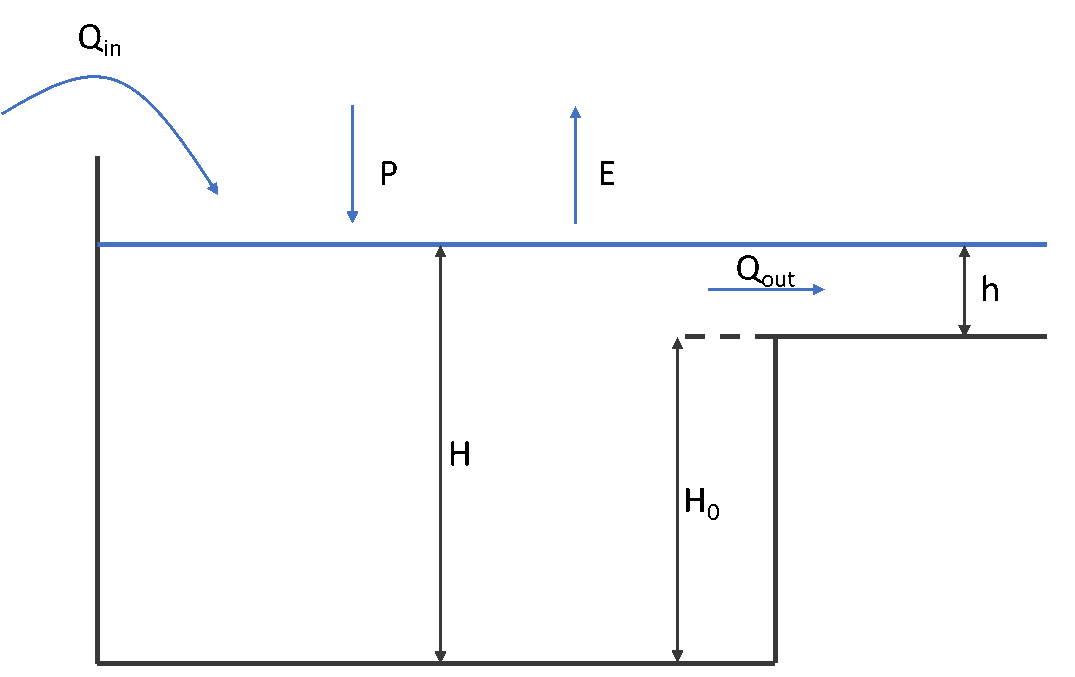Reservoirs and Lakes
Reservoirs and lakes models can be included as part of the river network.
Reservoirs
By default the reservoirs are not included in the model. To include them put the following lines in the TOML file of the model:
[model]
reservoir__flag = trueFinally there is a mapping required between external and internal parameter names in the TOML file, with below an example:
[input]
reservoir_area__count = "wflow_reservoirareas"
reservoir_location__count = "wflow_reservoirlocs"
[input.static]
reservoir_surface__area = "ResSimpleArea"
"reservoir_water_demand~required~downstream__volume_flow_rate" = "ResDemand"
reservoir_water_release-below-spillway__max_volume_flow_rate = "ResMaxRelease"
reservoir_water__max_volume = "ResMaxVolume"
"reservoir_water~full-target__volume_fraction" = "ResTargetFullFrac"
"reservoir_water~min-target__volume_fraction" = "ResTargetMinFrac"The list of reservoir input parameters that can be provided through the TOML file can be found here.
Lakes (unregulated and regulated)
Lakes are modelled using a mass balance approach:
where

Most of the variables in this equation are known at the current or previous timestep, apart from
- Come from the interpolation of field data linking volume and lake height,
- Be computed from the simple relationship
Rating curves in wflow can either:
- Come from the interpolation of field data linking lake outflow and water height, also appropriate for regulated lakes/ dams,
- Be computed from a rating curve of the form
Modified Puls Approach
The Modified Puls Approach is a resolution method of the lake balance that uses an explicit relationship between storage and outflow. Storage is assumed to be equal to
Inserting this equation in the mass balance gives:
The solution for
where
Lake parameters
By default, the lakes are not included in the model. To include them, put the following line in the TOML file of the model:
[model]
lake__flag = trueThere is also a mapping required between external and internal parameter names in the TOML file, with below an example:
[input]
lake_location__count = "wflow_lakelocs"
lake_area__count = "wflow_lakeareas"
[input.static]
lake_surface__area = "lake_area"
lake_water__rating_curve_coefficient = "lake_b"
lake_water__rating_curve_exponent = "lake_e"
lake_water__rating_curve_type_count = "lake_outflowfunc"
lake_water__storage_curve_type_count = "lake_storfunc"
lake_water_flow_threshold-level__elevation = "lake_threshold"
lake_water_level__initial_elevation = "lake_waterlevel"The list of lake input parameters that can be provided through the TOML file can be found here. The following lake storage curve types lake_water__storage_curve_type_count are available:
- 1 for
- 2 for
And the following lake rating curve types lake_water__rating_curve_type_count are available:
- 1 for
- 2 for general
- 3 in the case of Puls Approach
Additional settings
Storage and rating curves from field measurement can be supplied to wflow via CSV files supplied in the same folder of the TOML file. Naming of the files uses the ID of the lakes where data are available and is of the form lake_sh_1.csv and lake_hq_1.csv for respectively the storage and rating curves of lake with ID 1.
The storage curve is stored in a CSV file with lake level H and corresponding lake storage S:
H, S
392.21, 0
393.21, 430202000
393.71, 649959000
394.21, 869719000The rating curve uses level and discharge data depending on the Julian day of the year (JDOY), and can be also used for regulated lakes/ dams. The first line contains H for the first column. The other lines contain the water level and the corresponding discharges for the different JDOY (1-365), see also the example below, that shows part of a CSV file (first 4 Julian days). The volume above the maximum water level of the rating curve is assumed to flow instantaneously out of the lake (overflow).
H
394, 43, 43, 43, 43
394.01, 44.838, 44.838, 44.838, 44.838
394.02, 46.671, 46.671, 46.671, 46.671
394.03, 48.509, 48.509, 48.509, 48.509
394.04, 50.347, 50.347, 50.347, 50.347
394.05, 52.179, 52.179, 52.179, 52.179Linked lakes: In some cases, lakes can be linked and return flow can be allowed from the downstream to the upstream lake. The linked lakes are defined in the lake~lower_location__count (standard name) input parameter that represent the downstream lake location ID, at the grid cell of the upstream lake location.
In every file, level units are meters [m] above lake bottom and not meters above sea level [m asl]. Especially with storage/rating curves coming from data, please be careful and convert units if needed.
References
- Bos M.G., 1989. Discharge measurement structures. Third revised edition, International Institute for Land Reclamation and Improvement ILRI, Wageningen, The Netherlands.
- Burek P., Van der Knijf J.M., Ad de Roo, 2013. LISFLOOD – Distributed Water Balance and flood Simulation Model – Revised User Manual. DOI: http://dx.doi.org/10.2788/24719.